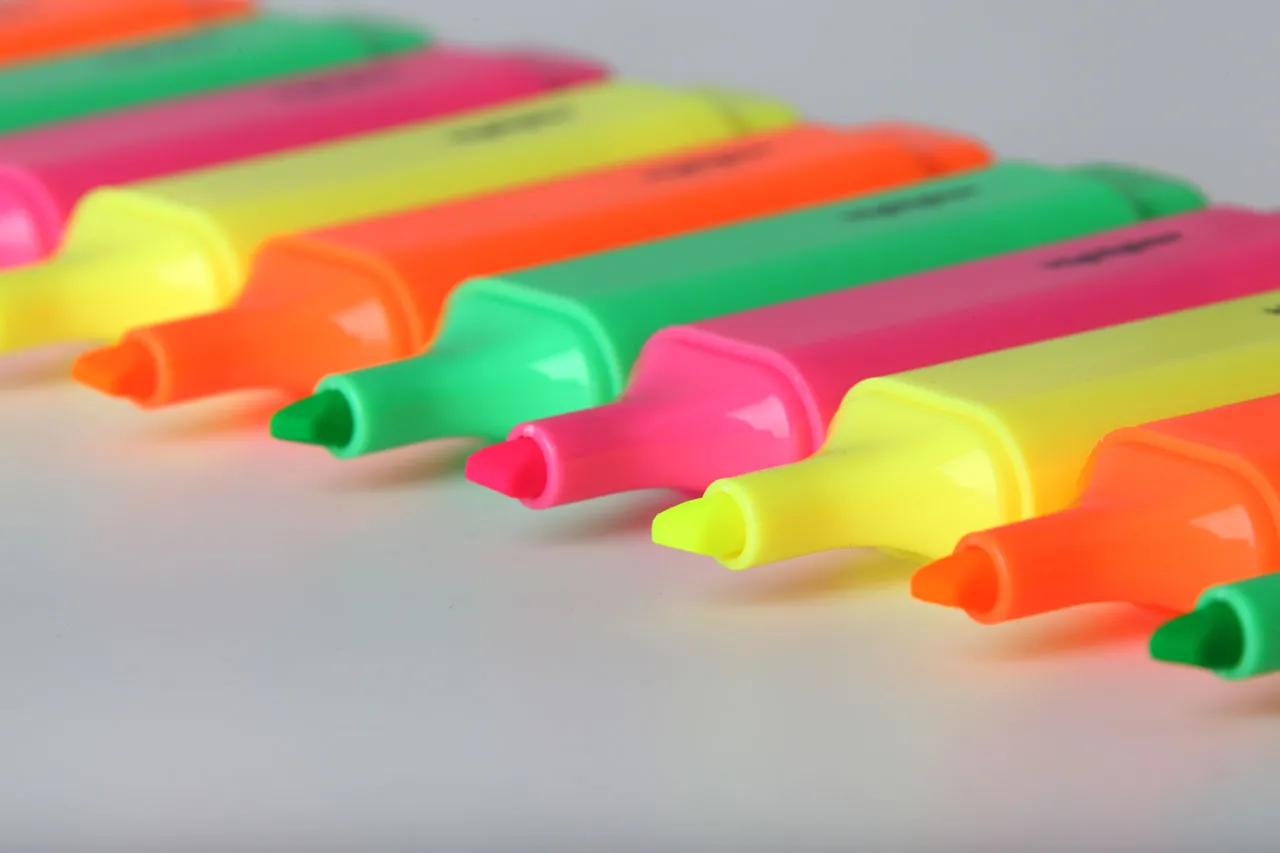Testing Digital Highlighters

“Make each program do one thing well."
— Doug McIlroy, inventor of Unix .
When I’m reading to learn, or when I’m reading for something to write, it helps me to mark key passages. Collected together, the passages give a personalized summary of what I’ve read. They’re immensely useful as quotes and references, for future writing and review.
With analogue reading, this is so easy: grab a pencil, or a highlighter, mark the passages as you go, done. It barely distracts from reading. The only friction comes later, since it isn’t so easy to search across the highlights, or to copy/paste them.
Reading online, it’s a different story for me. Right now, if I see something interesting, I copy it, paste it into a note in a separate application, and then return to what I’m reading to copy a link to the source, return to the note to paste it in, and return finally back to reading again. This process works, but toggling back and forth between apps while copy/pasting distracts from the reading experience. It’s even more cumbersome to do this with the smaller screens and slower processing on a phone or tablet. Is there a better way? I’ve decided to try and see.
Many apps provide a highlighting experience, but which one is right for me? I decided to review them and see what, if anything, meets my criteria:
- Highlights. The obvious criteria for a web highlighter is that it should help me highlight multiple key passages while I read online.
- Fewest Actions. Highlighting should work with the fewest number of actions possible. The reading is most important. Distractions must be minimal. Setup for a highlighting system should also be minimal, but I’m not opposed to a bit of technomancy, if it gets excellent results.
- Portable Highlights. I do not want to have to copy/paste every time I make a highlight, since that’s already what I do now. I’d like my highlights to be portable, especially into plain text files for use with my other notes. I’ll need a link back to the source to come along with whatever I’ve highlighted. This, too, should meet the “fewest actions” requirement. I prefer a synchronized method, but would settle for an easy export.
- Capture Anywhere. I read on Windows, Linux and Android systems, running on desktop, phone, and tablet devices. I need to capture highlights while reading on any of those. It doesn’t matter to me whether I’m reading a web page or a PDF, and I don’t want it to matter to my highlighter.
- Price. I’ll pay money (once please?) for the right features, if they’re out there, but I’d prefer a free tier at least for testing things.
A Pass/Fail Review
I’m reviewing the options strictly. If an option fails to meet one of the criteria, it fails for me, and I’ll move on, noting any pros and cons that catch my attention.

In other words, this is my own, extremely opinionated, subjective review based on my personal situation. If your needs differ from mine, perhaps my review could help you find a solution that works for you. We all have so many different approaches to this type of experience, and the good news is that there are also many options.
Web Clippers and Digital Highlighters
Options come and go, too. I noticed a few that are no longer developed, which is all the more reason for the “portability” criteria. If my highlights are stored with something that goes out of business, I want my stuff anyway. I focused on options that seemed likely to meet all my criteria, particularly for reading web pages vs. PDFs or electronic books on an e-reader. I tried to find newer options as well as the ones mentioned repeatedly on blogs and forums.
Glasp
glasp.co is billed as “a social highlighter” but then again Twitter does that. (Other people’s highlights are not one of my criteria.) How well does this newer app, still in beta, work for me? I couldn’t find a mobile app for Android so I stopped there. Otherwise, it seems to make good exports for use with plain text note files, so it could have potential for someone else.
grade: fail. no Android support.
Weava
weavatools.com offers a simple and attractive highlighter extension for browsers. Weava’s Android app is “in the pipeline” so I stopped there.
grade: fail. no Android support
Snippet
gosnippet.com is a highlighter app with no extra clutter in the way but it doesn’t offer an android app and exporting is a paid feature, so I didn’t try it out.
grade: fail. no Android support
Evernote
evernote.com offers an easy highlighter as a browser extension and mobile app. Select text, share to Evernote. Done. The trouble comes when you want to get the highlights out of Evernote. Most systems for copying from Evernote are meant for doing it all at once and only once, for when you’re moving away from Evernote. This doesn’t make for very portable notes or a minimal workflow. There are tools for syncing to text files in Dropbox, but that adds more complexity for me since I don’t already use DropBox.
grade: fail. cumbersome export
Liner
getliner.com is the most popular web highlighter for good reason. It’s simple and it works everywhere. To export the text though you have to do a download for every single highlight individually , or else click on a bunch of them. There’s no API or even a “download all” button. Without this, Liner is not for me.
grade: fail. cumbersome export
hypothes.is
hypothes.is is built to facilitate shared, collaborative highlighting and annotation on the web. I could overlook the dated look to the interface, and I have no use for the social/sharing aspects of it, but the experience of using it on my android phone or tablet is unacceptably clunky. It’s 2021 folks. Time for a mobile app. (I tried the app in Google Play Store that’s built to share with hypothes.is but when I tried it either it did nothing or showed an error message.)
grade: fail. no Android support
WorldBrain Memex
memex.garden is a beta product, and might ultimately become one of the more expensive options. It isn’t exclusively a highlighter.
(Memex includes additional functionality for searching across your browser bookmarks, and until recently you could also search your browser history. So often, I remember reading something and then hit a search engine trying to find it again, so I’d love a history search that includes the contents of what I’ve read, but I suppose they killed this feature for privacy reasons.)
I found the highlighting feature to be very easy to use in the browser, the mobile app works as expected, but I don’t see a way to get my highlights out of the system and into my notes. It’s a work in progress so maybe later.
grade: fail. exporting isn’t ready yet.
pocket.com is for making bookmarks, particularly of the “read it later” variety. I’m looking for a highlighter though. This fails my “minimal actions” criteria because I’d have to first save a redundant copy of the article, then open it in Pocket, then make any highlights. While it does allow you to highlight a passage while making the initial bookmark, the passage I chose was truncated.
grade: fail. it’s a copy machine with a highlighter tacked on
Pinboard
pinboard.in is also not a highlighter but it can work that way. Pinboard is my favorite system for bookmarking though. Select a passage of text, and with most of the interfaces it’ll be quoted in a bookmark description for that page. This works perfectly for me, and I already paid for it as a bookmarker, but it doesn’t let you create more than one highlight/bookmark for the same URL.
grade: fail. not a highlighter for multiple passages.
Readwise
readwise.io excels at making Kindle highlights easier to use. I already use and enjoy the Readwise plugin for Obsidian, for syncing Kindle highlights with plain text note files. Readwise can integrate with other highlighters, but I feel that adds undue complexity so I’m interested in whatever Readwise can do naively. The plugin for browsers works efficiently. The mobile app has a weird habit of dumping all your notes into a “highlighted from android” note, while all other notes are logically organized by the book or article they came from. You can circumvent the weird “android” note but I don’t want to have to retype the title of the source every time I make a highlight on my mobile device, so that’s a “soft” deal-breaker for me. I’ll overlook this annoyance until I find an option without it.
grade: almost. does everything I want with minimal extra actions in the way.
Diigo
diigo.com captures highlight nicely on my various devices. As for getting the highlights out of diigo and into into my notes, though… “Sync Diigo to Folder” is a Node package that will sync all your Diigo bookmarks to a directory as Markdown files. Intended for use with Obsidian. Requires Diigo API Key, a feature of paid subscription. I found it irksome that the exported highlights didn’t link to the original source, but to a copy of it on Diigo. This is done in order display the highlights along with the text, but I prefer text fragment linking for this.
grade: fail. almost passes, but it ommits links to the source of the highlights.
Conclusion: Confusion
When I set out to explore these many options, I expected to find several that work for me, and to pick one based on something subjective like highlighter colors.
Along the way I realized a few “negative criteria,” common features that don’t interest me or get in my way. Again, I’m looking for a highlighter here; not a bookmark, not a read-it-later duplicate copy of what I’m reading, and I’m not interested in making flashcards. Those are all related, useful, and not for me.
This isn’t about making web annotations either; I’m just highlighting. For my purposes right now, other people’s highlights or annotations are, well, beside the point. At worst, they’re more of the same dregs you get from web comments and maybe too similar. At best, they’re an interesting distraction, compounded by an invitation for dialogue, which is another distraction.
I also found barriers between highlighting a web page vs. a PDF vs. e-books of various formats. The experience differs also depending on the type of device you’re using, and of course a web service struggles if you’re working offline. I can imagine a system that transcends these barriers, but haven’t found one yet.
And the Winner Is
In the end, I found that nothing perfectly meets my admittedly strict set of criteria. Readwise comes extremely close with only one little annoyance. I will live with it for a while and see how it goes.
further reading: